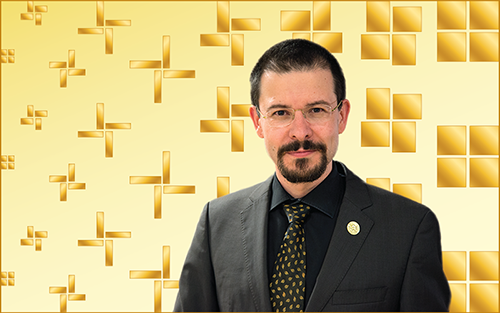Q&A: Where Chirality and Science Fiction Collide
Ventsislav Valev devours science-fiction novels, films, and TV shows, attributing his decision to become a physicist to his love of the genre. One of his favorite characters is Dexter, of the cartoon Dexter’s Laboratory. Dexter is a boy-genius who spends hours holed up in a secret laboratory under his parents’ house inventing gadgets such as a zapper that turns people into animals and a belt that allows its wearer to perform actions in reverse. Valev says as a kid he was captivated by Dexter’s passion for science and later chose the character’s catchphrase, “What a fine day for science!” as the inspiration for the greeting on his Skype page and business card. Now an Associate Professor at the University of Bath in the UK, Valev heads a group that studies the light-bending properties of chiral plasmonic nanoparticles—systems firmly rooted in reality but fantastic enough to be found in Dexter’s lab. In an interview with Physics, Valev explains his fascination with materials made from chiral particles and their seemingly futuristic and far-out uses, which range from invisibility cloaks to nanorobotics.
–Katherine Wright
Could you explain what a chiral plasmonic particle is and how it interacts with light?
Chiral plasmonic particles are basically tiny twisted wires that are often made of gold. The twist is the chiral, or “handed” part—it can wrap in two possible ways, which are mirror images of one another like your left and right hand. The gold is the plasmonic part—its surface electrons can oscillate collectively when they interact with light. A chiral plasmonic particle can alter light’s properties in the near field; for example, it can affect the intensity of light, its polarization, and its twist. The changes depend on both the geometry of the particle and the material that it’s made from.
Why are you studying chiral particles?
The optical effects of chiral systems were discovered some 200 years ago. Since then, chirality has mostly been thought of as a Boolean property—an object is either chiral, or it isn’t. But with new technologies, my colleagues and I are discovering that chirality is more complex.
How so?
We recently did an experiment where we morphed a chiral, cross-shaped structure made of gold from one handedness to another—a process called enantiomorphing—and tracked its interaction with light. Naively, I thought that the particle’s optical response associated with its chirality would go to zero and then gradually increase again as the nanoparticle transitioned from one handedness to another. But instead the response went through zero three times.
This weird finding tells us that light interacts with the structures in a more complicated way than we had anticipated. Realizing that is important: If we better understand how these particles interact with light, then we can tailor their properties for a specific application.
What are some uses for these crosses and other chiral nanoparticles?
Superlenses and invisibility cloaks could be created from arrays of chiral nanoparticles. The secret ingredient is using chirality to engineer the particles so that an assembly of them produces a material with a negative refractive index.
Chirality could also be exploited to count the steps of a nanorobot. Imagine a nanosized stick figure. At rest, the figure is perfectly symmetric. But when the figure takes a step, moving its left arm and right leg forward, it becomes chiral. With the next step the figure’s chirality reverses. If you illuminate this nanorobot with light, the switch from one chirality to the other could be detected by looking for a corresponding change in the outgoing light’s polarization.
As well as reading a lot of science-fiction books, you also write science-fiction short stories and novels. Can you tell me about that?
I wrote most of my stories while I was a Ph.D. student, although I am working on a new novel at the moment. My writing mixes science fiction with fantasy. For example, in my first novel the main character is an occult healer who turns into a vampire and acquires an artificial intelligence companion that lives symbiotically in his mind. The novel is a metaphor for scientific education, where the irrational human mind—prone to superstition and contradictions—learns to live with scientific logic. The story also blends in some folk culture from my home country of Bulgaria.
Have chiral materials ever featured in your science fiction stories?
Not yet. But nanotechnology and lasers come up often.
Katherine Wright is a Senior Editor for Physics.
Know a physicist with a knack for explaining their research to others? Write to physics@aps.org. All interviews are edited for brevity and clarity.





